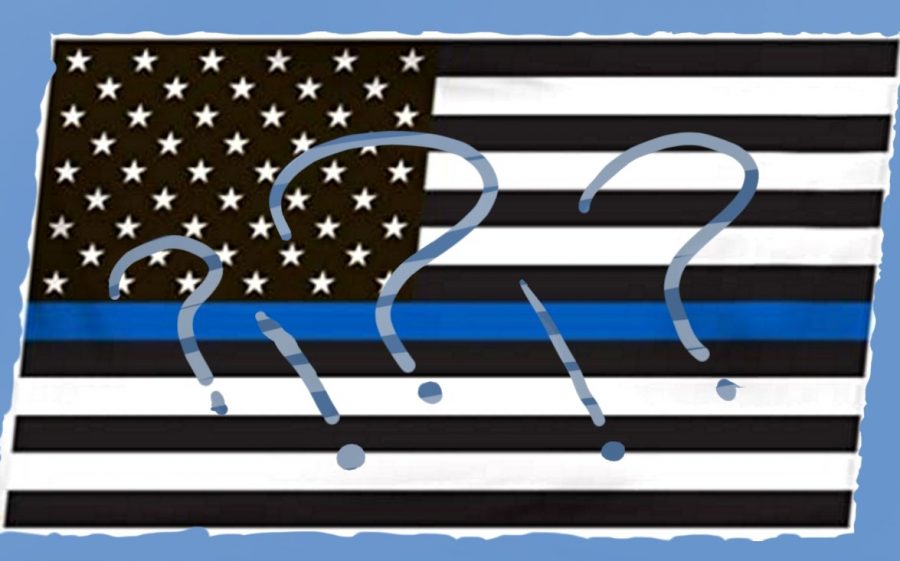OP-ED: Do Blue LINES Matter?
The Meaning Behind the Thin Blue Line Flag and Its Connotation
November 10, 2020
On October 30, Pelham Union Free School District employee Lois Miceli was asked to remove her “Thin Blue Line” flag facial-mask. In an interview with Channel 12 News Miceli said, “I was told that by wearing it, I was making a political statement. I was shocked, I was taken aback, I was insulted.”
Miceli wears the mask in support of her son, an NYPD officer. Police officers face incredible risks due to the nature of their jobs. Those who support officer’s brave choice to risk their life and safety for others by wearing this symbol do not intend to incite hatred or support racial injustice. It is meant as a token of support, just as an American flag pin is often seen as a sign of support for our troops abroad who take similar risks. Is such an action a “political statement?”
At issue, perhaps, is the meaning of the symbol. While the symbolism of one group, The Thin Blue Line, was intended to demonstrate support for the police, another group Blue Lives Matter, has co-opted the symbol and, in some cases, corrupted the idea to represent white supremecist values. It is this misidentification that seems to be the source of the current controversy in Pelham. Some students, correctly or incorrectly, see others wearing this sign, and view it with terror.
It’s natural that our nerves are raw when it comes to issues of race. Our nation has been in the throes of a period of turmoil, full of distrust, hatred, and violence. On May 25, 2020, George Floyd, a husband, father, and American citizen, was murdered by former Minneapolis police officer Derek Chauvin. Floyd’s death, for many, indicated the reforms that need to be made to rid nationwide police forces of systemic racism. This inspired the rise of the Black Lives Matter movement, which drastically increased the presence of people of color (POC). POC were encouraged to speak out against our nation’s racial disparities and the innocent Black lives that have been lost at the hands of police officers. Numerous sit-ins, marches, and gatherings took place in support of the movement throughout the nation.
The Blue Lives Matter movement, was created in response to the Black Lives Matter movement, and was rooted in hate and vengefulness. Comparing the struggles of black lives to that of “blue” lives is like comparing apples and oranges, demeaning both in the process. There is no such thing as a “blue life.” One can remove a uniform at the end of a workday; one cannot strip away their race.
However, often associated with the movement is the Thin Blue Line flag , a black and white model of the American flag with one blue line. This term was originated in the 1950s by Los Angeles Police Chief Bill Parker, and so had nothing to do originally with Black Lives Matter. This flag has been in use for seventy years, created to represent the courage and sacrifice of police officials. The black flag represents those officers who have fallen in the line of duty; the blue line represents those who continue to maintain the peace. Current president of the Thin Blue Line company, Andrew Jacob states, “The flag has no association with racism, hatred, bigotry,” following with, “It’s a flag to show support for law enforcement—no politics involved.”
Regardless of this, some aren’t aware of the difference between what the two groups stand for, causing the imagery of the Thin Blue Line flag to make some fearful. Because of this, law enforcement officers have become, to some, “the enemy,” Jacob states.
Police officers themselves recognize both the fear of community members and the controversy caused by those who seek to politicize their jobs, and they are torn. The New York Times recently interviewed Lieutenant Edwin Raymond, a Black officer working for the NYPD. Raymond spoke about his experience during the Black Lives Matter and other racial justice-related protests.
“I’m not blind to the issues, but I’m torn […] As I’m standing there with my riot helmet and being called a [racial epithet] people have no idea that I identify with them. I understand them. I’m here for them. I’ve been trying to be here as a change agent.”
The Thin Blue Line flag represents support for law enforcement, regardless of an officer’s skin color. The original purpose of the Thin Blue Line flag is not rooted in hate. So, who gets to decide what the connotation of a symbol is?
Rather than reacting in an impulsive way if someone misinterprets the intended meaning of a symbol, perhaps we could make better use of the situation by turning it into a teachable moment and opening up a dialogue. At the same time we could also take a moment to consider whether a symbol might be viewed as hateful, even if that was not its intent, and be understanding of others’ fears. A little understanding goes both ways.




